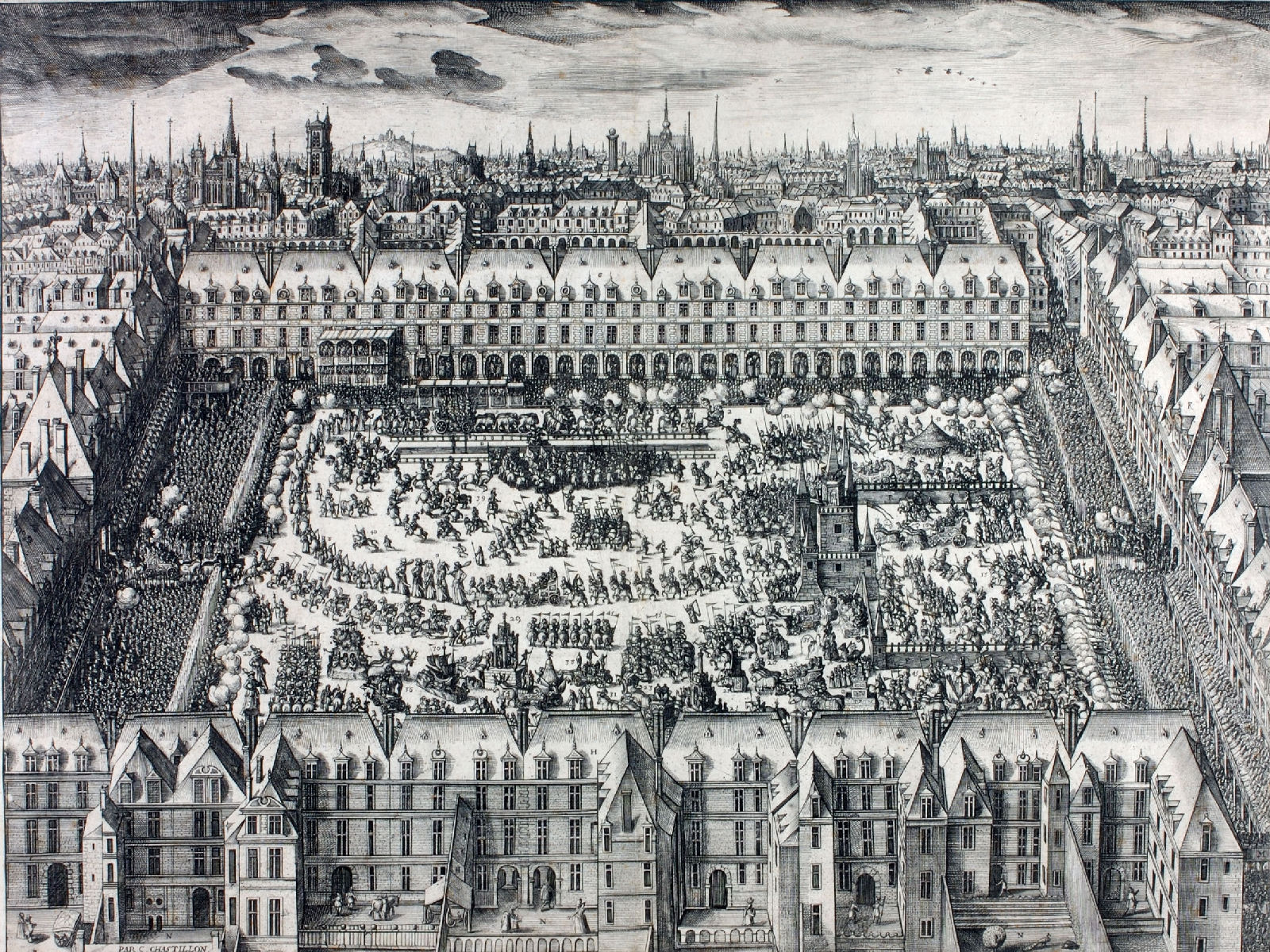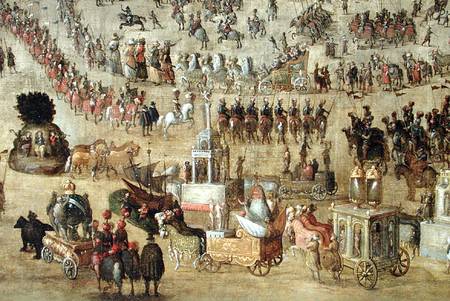The Place des Vosges -- The Uses of Public Space
Joan DeJean, How Paris Became Paris: The Invention of the Modern City (New York: Bloomsbury,2014), pp.49-54.
The new Place was designed as a radical departure from earlier models for city squares -- the Classical forum or the Renaissance piazza -- usually rectangular and designed to showcase an individual monument, a church, a town hall, or a central statue. The Place Royale was literally a square: seventy-two toises by seventy-two toises, or nearly four hundred and fifty feet square. And it had neither a political nor a religious mission. Despite its name, there was initially nothing royal about it: its center was in fact empty until 1639, when a statue of Louis XIII was added. The first modern square instead focused attention on great architecture that was designed for the inhabitants of a city rather than to celebrate its civic or religious authorities. It became an important origin of the French capital's lasting association with cutting-edge residential architecture.
Detail of Painting of the Opening Ceremony of the Place Royal, 1612 |
The large open space also helped launch Paris' love affair with perspective. Before its completion, only the Pont Neuf had provided the kind of vantage point necessary for the proper appreciation of a monument – even Notre-Dame Cathedral was closely hemmed in by constructions of various kinds. But by the end of the seventeenth century, all over the city various broad thoroughfares provided those exploring on foot with the distance necessary for contemplation of the buildings found there; boulevards and avenues made possible long-range views of the best-known monuments.
In the early seventeenth century, the French court had no regularly designated spot to stage festivities. The traditional site, the Hotel des Tournelles, had been abandoned in 1559 by Queen Catherine de Medicis after her husband Henri II was killed in a joust organized on its grounds; she later ordered it to be demolished. . . .
On April 5, 6, and 7, 1612, the new space was officially opened to the public with one of the grandest public parties Paris had ever known. The occasion chosen was a momentous one: the celebration of the so-called "Spanish marriages," the engagements of Henri IV's two oldest children to two offspring of Philip III of Spain: the eleven-year-old future Louis XIII to the Infanta Ana, also eleven, and ten-year -old Elisabeth of France to the future Philip IV, then a boy of seven. . . .
Pinpointing the size of a large crowd is something that remains elusive even with modern surveillance equipment, so it's no surprise that estimates of the number who assembled for the festivities vary wildly, from 50,000 to 80,000. The Royal Square had been designed to accommodate over 60,000 -- a quarter of the roughly 225,000 people who then lived in Paris --and Chastillon depicts it containing a capacity crowd. One commentator explained that so many people had spent the night on the Place to be sure of getting a spot that, by dawn on April 5, it was already jammed; additional spectators filled every arcade. Another commentator added that spectators had even managed to find perches all over the roofs. Still another concluded: "It seemed as if the entire city of Paris was trying to find a spot near the square." One of the greatest diplomats of the age was an eyewitness: he remembered above all the "incredible" sound of the seemingly "infinite" crowd roaring as one. With this spectacular occasion, the square was inaugurated as the people's park, a space for all Parisians.
That overflow crowd witnessed a carefully scripted event, a cross between a parade and a play. In the center of the Place, a miniature re-creation of the pavilions around the square was named the Palace of Happiness, in a nod to the prosperity promised by the double marriage. A cast of thousands -- about five thousand or so-paraded around it. There was a medieval princess atop a dragon that spat fire from its mouth; there were bands of slaves and savages, Indians and giants, pages and trumpet-blowers-with a half-dozen elephants and a rhinoceros thrown in for good measure.
And the costumes were as extravagant as the stage set. Those "savages," for example, were covered from head to toe with oak leaves made from green silk satin. The "Indians" wore plumed headdresses -- also feather boas and even feather-covered ankle boots. The men of the French court sported outfits in gold lame-and diamond bracelets.
Henri IV's widow, Marie de Medicis, understood that this event could become the kind of experience that Parisians had not often known in recent decades, one that gave them a sense of a shared identity that transcended religious differences. At the end of the second day, she therefore announced that the celebration would be continued in the city's streets so that "the Parisians who had not been able to find a place in the Place Royale could see all these won derful things." Led by the royal family, a huge procession filed out of the square, down the rue Saint-Antoine, over the Notre-Dame bridge to the Left Bank, then proceeded along the embankment to the still very new Pont Neuf, where it crossed the Seine once again to reach the Louvre.
When night fell , Marie de Medicis asked "all those who lived in houses along the parade route" to light a lantern in each of their windows to illuminate the sights for the throngs who had quickly gathered up and down the route. More than six hours later and well after midnight , the last participants finally reached the Louvre. By then, it could truly have been said that virtually all Parisians had participated in the inauguration of the Place Royale. . . .
In the 1605 documents that established the Royal Square, Henri IV had assigned it a final function: to become a "proumenoir," "a space where the inhabitants of our city can walk; they are now tightly confined within their homes because of all the people who keep flooding into Paris in such numbers from all sides." He thus became the earliest monarch to address the need for a second and then unheard of type of public space: space intended for the everyday recreational use of the inhabitants of increasingly populated urban centers. With the Place Royale, Paris acquired the first purpose-built public recreational space in any European capital.
This seventeenth-century depiction of the Place Royale testifies to the way Parisians embraced it on a daily basis. Men and women, adults and children, nobles and bourgeois walk in the central square, under the arcades, and in the surrounding streets. Some are alone, others in pairs or in groups. Two boys chase each other. Some people lean on the fence; some sit on it, others on the ground nearby. Itinerant peddlers roam the streets; a few aristocrats on horse back practice their martial arts. At a time when few homes had space set aside for social activity, the Place Royale was an immense outdoor living room where Parisians could enjoy their leisure time together. And they could do so, moreover , every day of the year. No early guide to the city of Paris failed to mention that because of the covered arcades "one can have the pleasure of walking no matter what the weather, protected from the sun as well as the rain."

Claude Chastillon, Inauguration of the Place Royal, 1612
[Chastillon actually lived on the Place Royal and was present at the official opening of this public space.]
